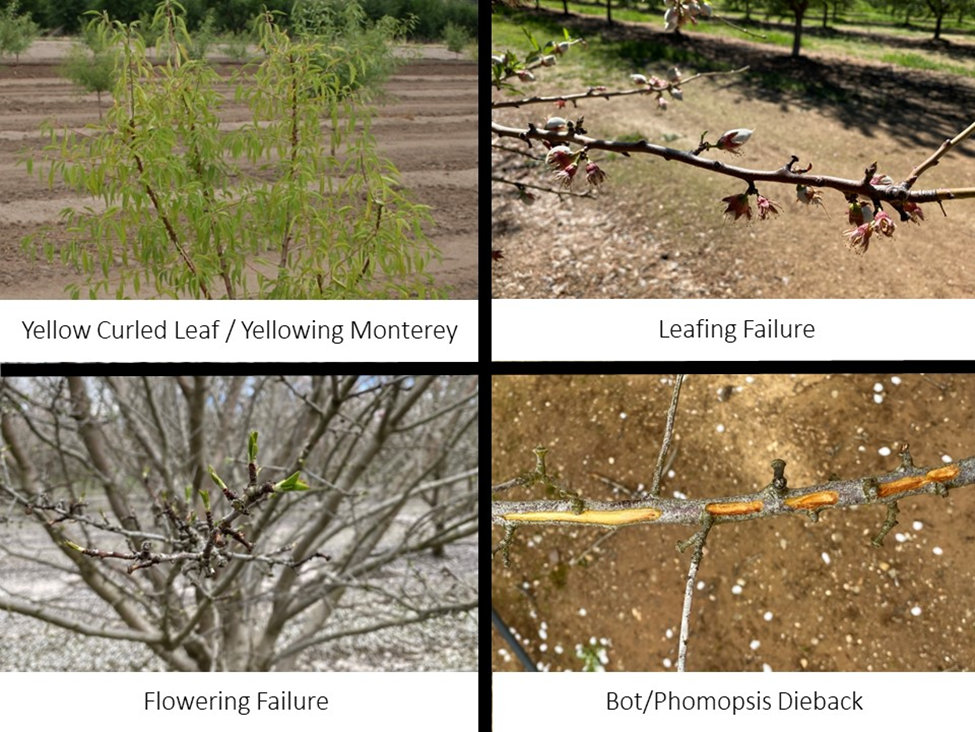Over the past eight years, four new problems have arisen as major challenges for some Sacramento Valley growers as they work to establish and manage their Monterey almond trees. These four problems have not been studied in UCCE replicated and randomized field trials – instead we are relying on the establishment of patterns from individual grower experiences in the Sacramento Valley as well as anecdotes from Australian almond production. Over the past eight years with a growing list of Monterey maladies a single throughline has become well-ingrained: water.

From upper left to lower right, disorders with the Monterey almond variety: Yellow Curled Leaf (YCL)/Yellowing Monterey, Leafing Failure, Flowering Failure, and Bot/Phomopsis Dieback. Photos: YCL photo by Franz Niederholzer, other photos from Luke Milliron. Details on these four maladies can be found at: growingthevalleypodcast.com/podcastfeed/monterey
Too little water:
Many growers accuse the Monterey variety of being a canary in the coal mine when it comes to water stress. One Glenn County grower who had a Ceres Imaging (remote sensing via airplane) flight over his orchard noted that the Monterey rows showed up bright red, indicating water stress. As we head towards harvest, keep in mind that extreme water stress has well known downsides – nut shrivel (reduced nut value), and the potential to reduce the flower buds for 2025 during bud differentiation (happens around the time of hull split). Water stress can be particularly challenging to avoid in the northern Sacramento Valley where many growers have full-coverage sprinkler irrigation that prevents them from watering their late harvesting Montereys while other varieties are dried down for shaking or nuts are on the orchard floor. Given these well-known downsides of extreme water stress, do what you can this harvest season to quickly get water back on stressed Montereys. However, when it comes to this growing list of Monterey maladies, I don’t yet have a consistent pattern from grower stories of previous water stress being linked to the various problems.
Too much water:
A history of excess water has been a consistent through-line in anecdotes about all four of the new Monterey maladies. Yellow curled leaf / yellowing Monterey has been found in our wettest springs (e.g. 2017) and trees have improved when excess soil moisture was corrected. Monterey leafing failure was previously induced by UC researchers in an over-irrigation experiment. In both California and Australia there is a weak link to seeing the problem following wet years (problem years in CA in 2018 and 2020 following wet 2017 and 2019 springs, respectively). Flowering failure has also been linked by UC researchers to excess water in the previous year, in particular because the problem appears low in the canopy where water status is wettest, and typically-smaller Monterey canopies can be over-irrigated season-long if you’re irrigating for the larger Nonpareil trees. The newest problem – sudden branch dieback of Monterey canopies from Botryosphaeria and Phomopsis cankers in several Glenn County orchards in spring 2024 is the least well understood malady. However, one observant grower noted that his Montereys on heavier ground with nuts that stayed green through hull split (presumably wetter trees) are now the trees with severe dieback compared to trees that experienced more typical hull split and harvest water stress. Too much water for too long is associated with a growing list of Monterey maladies.
From too much to too little?
There is the potential for Montereys to be both too wet and too dry in the same season. Spring is the critical root growth period in almonds and too much water from rain or irrigation can kill the fine roots that are responsible for water uptake. Therefore, these trees go from too wet in spring to showing extreme stress late in the year during the hot harvest season, not necessarily because there isn’t soil moisture, but because they don’t have healthy roots to take up the water. Finding and maintaining the sweet spot in tree water status between too wet and too dry season-long is very difficult without a plant-based water status monitoring tool like the pressure chamber (pressure bomb), or an automated technology like FloraPulse that directly measures the water status of the tree. You can learn more about the pressure chamber at: sacvalleyorchards.com/manuals
Still learning:
We have lots more to learn – and the ideas for explaining the causes of these maladies are subject to change. We need additional details from grower and PCA experiences to continue our learning. If you have information you believe would be useful, please shoot me a text at: (530) 828-9666.
What Monterey maladies?
If you are surrounded by lush and productive Montereys and none of these problems are evident – be thankful. The northern Sacramento Valley where these problems are plaguing select orchards is a unique place – highest rainfall in the Central Valley, more full coverage sprinkler systems, and almost exclusive use of the Krymsk 86 rootstock. However, please take away that wherever you grow, too much water often leads to orchard maladies. Even in the depths of the two previous droughts, UCCE orchard advisors most often traced orchard maladies back to a history of too much water, not too little. Irrigation management is difficult, and grower stress about water stress is universal. However, it’s a skillset that yields great benefits to orchard health with continual improvement.


Leave a Reply